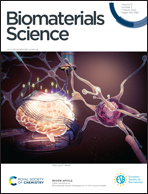Biomaterials-based strategies for in vitro neural models
Abstract
In vitro models have been used as a complementary tool to animal studies in understanding the nervous system's physiological mechanisms and pathological disorders, while also serving as platforms to evaluate the safety and efficiency of therapeutic candidates. Following recent advances in materials science, micro- and nanofabrication techniques and cell culture systems, in vitro technologies have been rapidly gaining the potential to bridge the gap between animal and clinical studies by providing more sophisticated models that recapitulate key aspects of the structure, biochemistry, biomechanics, and functions of human tissues. This was made possible, in large part, by the development of biomaterials that provide cells with physicochemical features that closely mimic the cellular microenvironment of native tissues. Due to the well-known material-driven cellular response and the importance of mimicking the environment of the target tissue, the selection of optimal biomaterials represents an important early step in the design of biomimetic systems to investigate brain structures and functions. This review provides a comprehensive compendium of commonly used biomaterials as well as the different fabrication techniques employed for the design of neural tissue models. Furthermore, the authors discuss the main parameters that need to be considered to develop functional platforms not only for the study of brain physiological functions and pathological processes but also for drug discovery/development and the optimization of biomaterials for neural tissue engineering.



 Please wait while we load your content...
Please wait while we load your content...